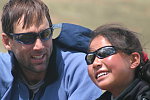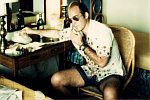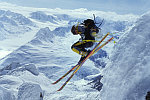 Shadows off the beaten path
Shadows off the beaten pathSTEEP | WALTZ WITH BASHIR
< < D O C S > >
last update 17.Sep.08
See also: SHADOWS FILM FESTIVAL
 R E V I E W B Y R I C H C L I N E
R E V I E W B Y R I C H C L I N E
with Erik Weihenmayer, Sabriye Tenberken, Tashi Pasang, Kyila, Sonam Bhumtso, Tenzin, Gyenshen, Dachung, Jeff Evans, Paul Kronenberg, Gavin Attwood, Michael Brown
 release US 5.Mar.08,
release US 5.Mar.08, UK 8.Aug.08
06/UK 1h44
TORONTO FILM FEST BERLIN FILM FEST
 It's the subject matter that makes this film an absolute triumph, documenting a story from a distant part of the world that really needs to be told. That the film itself is a bit uneven and awkward is almost beside the point.
It's the subject matter that makes this film an absolute triumph, documenting a story from a distant part of the world that really needs to be told. That the film itself is a bit uneven and awkward is almost beside the point.
Global adventurer Erik was the first blind man to reach the top of Everest. Working with Sabriye, founder of Braille Without Borders in Tibet, Erik and a team of American climbers train six blind Tibetan teens so they can climb one of Everest's sister peaks. But the training raises issues in the kids' past (mainly in the case of Tashi), and Sabriye and her co-founder Paul are worried the Americans are pushing the kids too hard to achieve the summit.
Anyone with rudimentary cross-cultural experience can see that the Americans haven't a clue how to genuinely connect with this society. They also completely take over the film, squeezing the children into the sidelines and trying to tell local workers how to do their jobs. For the film, this is clearly an unintentional emphasis; it's extremely informative, but it's not the point.
Much better are the introductions to each kid, including a look at their pasts, their families and how their world opened up through connecting with other blind peopleas they deal with being stigmatised by their society, families and religious traditions. After these brief introductions, we don't get much more information about them, and they don't say much to camera during the gruelling climb, which is a shame.
Although there is the fascinating sideroad in which we follow Tashi to find his real family in China (this subplot is both unfinished and unspecific about whether it happened before or after the climb). As a result, Tashi emerges as the most interesting teen, with his unpredictable resilience and quirky personality. While of the foreigners, Sabriye comes across as having the most cultural sensitivity.
As filmmaker Walker lets the material slip out of her grasp, she falls into the Americans' trap of defining the event based on its "success" or "failure", then learning, also like them, that these concepts are fairly irrelevant beyond the West. But this adds an intriguing layer to an important, heart-soaring record of a group of incredibly brave people doing something almost everyone would tell them is impossible.
23.Jul.08
 R E V I E W B Y R I C H C L I N E
R E V I E W B Y R I C H C L I N E MUST
MUST  SEE
SEE
scr Hunter S Thompson, Alex Gibney
with Johnny Depp, Sondi Wright, Anita Thompson, Juan Thompson, Ralph Steadman, Jann Wenner, Tom Wolfe, Jimmy Carter, George McGovern, Pat Buchanan, Gary Hart, Jimmy Buffett
 release US 4.Jul.08,
release US 4.Jul.08, UK 19.Dec.08
08/US Magnolia 1h58
SUNDANCE FILM FEST

See also:
EXCLUSIVE INTERVIEW WITH ALEX GIBNEY
 With a wealth of archive material, documentary filmmaker Gibney assembles a remarkably astute and comprehensive look at the life of one of the most notorious journalists in American history.
With a wealth of archive material, documentary filmmaker Gibney assembles a remarkably astute and comprehensive look at the life of one of the most notorious journalists in American history.
Hunter Thompson invented his own style of journalism, which was first called "gonzo" in 1970. Notable for putting himself right into the story, he used outrageous quotes and comments and an almost frighteningly honest approach that avoided any sense of what we'd now call political correctness. Through his career, Thompson covered presidential campaigns and astutely examined the dark realities of the American dream. He committed suicide, as he always promised he would, at age 68 in 2005.
In making this film, Gibney had unprecedented access to Thomson's home movies, private photos and unpublished writings, as well as his family and friends. Not to mention people he worked for and politicians he wrote about. This wide range of interviewees provides a wonderfully rounded picture of the man, his genius and madness, and the way he inspired some people and infuriated others.
It's narrated on-screen and off by Depp (who played Thompson's alter ego in the movie version of Fear and Loathing in Las Vegas) in Thompson's own words, read from his books and articles, plus a treasure trove of audio clips featuring Thompson himself. We also get startlingly personal insights from wives Sondi and Anita, son Juan, and his iconic illustrator Steadman. All of this material is gorgeously edited together with witty visuals and a superb song score.
This is a raucous portrait of a man who loved illegal drugs and big guns and considered "freak" to be an honourable designation. Unlike most journalists, he was never afraid to speak the raw, brutal truth and burn his bridges behind him. He spent his life looking for an honest politician he could back, and found only one or two (famously wondering, "How low do you have to stoop in this country to be President?"). In his later years, he became a prisoner to his own myth, the character he created. And Gibney beautifully captures the simple truth that we need writers like Thompson now more than ever.
8.Sep.08
 R E V I E W B Y R I C H C L I N E
R E V I E W B Y R I C H C L I N E
with Doug Coombs, Bill Briggs, Eric Pehota, Glen Plake, Seth Morrison, Shane McConkey, Ingrid Backstrom, Chris Davenport, Stefano De Benedetti, Rick Armstrong, Greg Stump, Lou Dawson

release US 21.Dec.07,
UK 26.Sep.08
07/US 1h32
 This documentary about extreme skiing is packed with beautiful camerawork and terrific archive footage. But while it desperately wants to crossover to a mainstream audience, it is what it is: a movie for skiers.
This documentary about extreme skiing is packed with beautiful camerawork and terrific archive footage. But while it desperately wants to crossover to a mainstream audience, it is what it is: a movie for skiers.
The film traces, from an American perspective, the rise of free-skiing around the world through the 1970s and '80s and up to the present, as skiers left their local pistes in search of near-vertical slopes of virgin snow in the Rockies, Alps and Alaska's Chugach range. Originally, men like Briggs were mountaineers who climbed the peaks and skied where no one had skied before. In Europe, skiers like De Benedetti pioneered especially steep routes. And then they started using helicopters to find ever-more inaccessible places, and iconic skiers like Plake, Backstrom, McConkey, Coombs and Morrison became more like rock stars.
Incredibly wealthy rock stars, it should be added. Because even though the early skiers felt that "everyone should be doing this", it's clearly only something wealthy people can do. And this rather closed club atmosphere infuses the whole movie, as skiers, journalists and photographers all speak in awed tones about each milestone and achievement, especially those who have died while pursuing their passion. Meanwhile, filmmaker Obenhaus loads this doc with slow-motion and heart-tugging music.
It's not a very complicated film; events of the past four decades are presented chronologically, and most of the interviewees are much better on the slopes than they are speaking to a camera. They don't have much perspective on their sport or even their own lives; one actually says, "I don't think I'm an adrenaline junkie," right before skydiving off a bridge. And here's where the film actually gets interesting: as an examination of what makes people push themselves to do something so obviously dangerous.
The answer probably lies partly within the film itself, as the images of people rocketing down mountainsides are absolutely breathtaking. Even the archive footage of much earlier skiers is impressive. And the human achievement--pushing boundaries of endurance and skill beyond logical boundaries--is only bettered by the jaw-dropping mountain scenery, beautifully shot by photographers in helicopters and on the slopes next to the skiers. It all goes to show that people will find challenges everywhere on earth and take themselves to the limit to achieve something special.
24.Jul.08
 R E V I E W B Y R I C H C L I N E
R E V I E W B Y R I C H C L I N E MUST
MUST  SEE
SEE
voices Ari Folman, Mickey Leon, Ori Sivan, Ronny Dayg, Yehezkel Lazarov, Shmuel Frenkel, Ron Ben Yisahi, Dror Harazi, Zahava Solomon
 release Isr 12.Jun.08,
release Isr 12.Jun.08, UK 21.Nov.08,
US 25.Dec.08
08/Israel 1h27
CANNES FILM FEST

 Quite possibly the first-ever feature animated documentary, this strong story of war and memory from Israel is essential viewing for anyone interested in film. Or in the Middle East.
Quite possibly the first-ever feature animated documentary, this strong story of war and memory from Israel is essential viewing for anyone interested in film. Or in the Middle East.
In a bar one night, Boaz (voiced by Leon) tells his friend, filmmaker Ari, about a recurring dream involving 26 dogs. They eventually connect this to their military service in the early 1980s, during the Lebanese War. Ari is disturbed that he can remember nothing about his own experiences, although he knows he must have been present at the horrific Sabra & Shatila massacre. So he travels to interview his old friends and piece together these missing years.
The story is told through a unique animation style that brings to mind Richard Linklater's A Scanner Darkly--strikingly realistic scenes that blur into dreamlike imagery. But this is distinctly documentary, as all but two voices are the actual people (and the other two are word-perfect recreations), with Folman using the animation to venture into the minds of the people involved. At its core, this is his experience of not wanting to remember but needing to know the truth.
And it's strikingly powerful, getting to the root of a controversial and horrific event through an examination of how easily our own minds can play tricks on us. "Memory takes us where we need to go," is the key phrase, and after 20 years these men finally might be ready to come to terms with their own fear, horror and guilt. And as the truth starts to reveal itself, the images of violence are truly unsettling.
Visual artistry adds a remarkable layer of detail and meaning to the haunting story. Scenes are gorgeously rendered to capture the camaraderie and isolation of wartime, as well as a variety of rich settings: swimming in the sea, whispering in cafes, driving through snow-covered European fields, partying on a boat, plus sudden destruction and random violence. There are also more surreal memories, including some that merge eerily with glimpses of the Nazi era.
It's beautifully inventive and thoroughly cinematic. And in the end, Folman vividly combines the complex recollections of the interviewees, plus some climactic news footage, to present the events in a powerful way that leaves us in no doubt who is to blame for the pointlessness of war--this one or any other.
31.Jul.08


See also: SHADOWS FILM FESTIVAL
© 2008 by Rich Cline, Shadows
on the Wall
